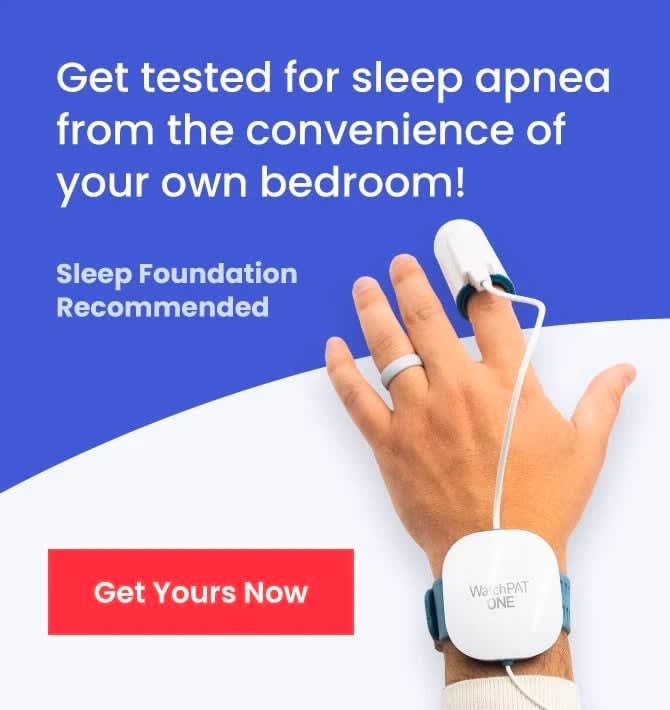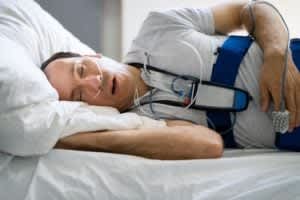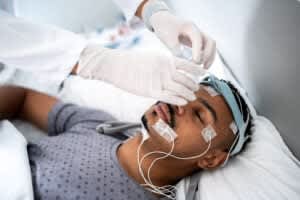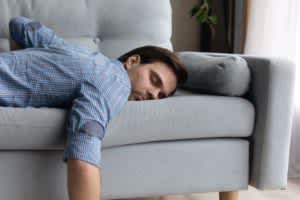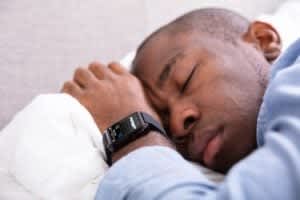Price:
$349Sleep Doctor Home Sleep Test Review
The content on this page should not be taken as medical advice, nor do we claim this test reflects diagnosis. Always consult your doctor in regards to using this device and any test results it may indicate. When you buy through our links, we may earn a commission. Products or services advertised on this page may be offered by an entity that is affiliated with us. Learn More.
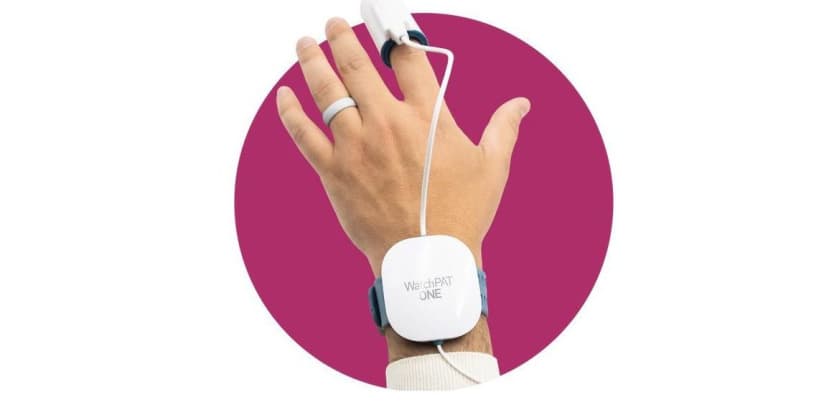
Sleep Foundation Special Offer
Use this SleepFoundation.org link for the most current discount on Sleep Doctor products
First announced in 2019 and now available for online purchase, the Sleep Doctor Home Sleep Test is an at-home testing device for obstructive sleep apnea (OSA). The device consists of chest, wrist, and finger sensors that monitor seven different bodily metrics associated with OSA. If worn properly, the Sleep Doctor Home Sleep Test can record enough data in one night to determine whether you qualify for an OSA diagnosis. The Sleep Doctor partnered with Itamar Medical to produce the device.
The Sleep Doctor Home Sleep Test is a true game-changer. Historically, most people have needed an overnight sleep study to receive an OSA diagnosis. Sleep studies are highly effective, but they can also be expensive and — for many people — inconvenient. While this is not the first at-home test for OSA, most earlier models have lacked the tracking technology needed for conclusive results. The Sleep Doctor Home Sleep Test makes the process of getting an OSA diagnosis faster, cheaper, and more convenient than traditional sleep studies.
What Is Obstructive Sleep Apnea?
OSA is a sleep disorder characterized by temporary loss of breath during sleep that causes people to snore heavily, choke, or gasp for air in their sleep. The condition occurs due to a physical obstruction blocking the breathing passages. Common causes of OSA include an enlarged tongue, swollen tonsils or adenoids, a shorter lower jaw, and growths on the roof of the mouth. Obesity can also lead to OSA.
People are diagnosed for OSA using a score known as the Apnea-Hypopnea Index (AHI). Apneas are a complete loss of breathing for several seconds, and hypopneas represent a partial loss of breathing. People with OSA may experience hundreds of apneic and hypopneic episodes during a single night. According to current AHI score guidelines, people who experience 30 or more episodes per hour have severe OSA.
People with OSA often experience excessive daytime sleepiness, irritability, and headaches the following day. They are also at greater risk for workplace accidents and vehicle collisions. Over time, people with OSA are more susceptible to heart failure, stroke, depression, and anxiety. For these reasons, doctors stress an OSA diagnosis is crucial for your immediate and long-term health.
How Does The Sleep Doctor Home Sleep Test Work?
The Sleep Doctor Home Sleep Test consists of a wristband attached to a finger probe and chest monitor. Using these three contact points, the device tracks seven metrics:
- Peripheral arterial tone, or changes to the volume of your pulse
- Heart rate
- Blood oxygen level
- Actigraphy, or your movements during sleep
- Body position
- Snoring
- Chest motion
These metrics are widely used to diagnose people for OSA. As long as the wristband, chest monitor, and finger probe remain secure, one night of sleep should yield sufficient results.
There are other steps you’ll need to take before and after wearing the device. The process is as follows.
- Step 1: After ordering the test, you’ll receive an email from iSleep Physicians Group with medical assessment forms. The Sleep Doctor recommends completing the forms as soon as possible to reduce the potential for delays.
- Step 2: Once your assessment forms have been received, you’ll receive instructions for scheduling an appointment with a licensed sleep doctor. This appointment is conducted via video chat. If you meet the medical criteria for OSA, you’ll be asked to test at home using the Sleep Doctor Home Sleep Test.
- Step 3: Wear the device while you sleep for one night. Your data is automatically sent to your assigned doctor.
- Step 4: You’ll receive an email with your AHI score and other test results. The email also prompts you to make a second appointment with the doctor.
- Step 5: During your post-testing appointment, the doctor covers the results and answers questions as needed. If they believe your results warrant an OSA diagnosis, they’ll prescribe continuous positive air pressure (CPAP) therapy or another treatment option.
How Do You Set Up and Use the Sleep Doctor Home Sleep Test?
You’ll need to download the WatchPAT One companion app before using the device. This app allows you to unlock the device on your phone with a product code, then walks you through the steps of securing the wristband, finger probe, and chest monitor. When everything is set up, you’ll press “start recording” to begin the test.
All three of the Sleep Doctor Home Sleep Test’s components are lightweight and unobtrusive. However, some people struggle to sleep as they normally would with the wristband, finger probe, and chest monitor in place. The latter may also come loose with sleep position changes. For this reason, you should secure the chest monitor with medical tape.
The Sleep Doctor Home Sleep Test transmits data to your phone throughout the night. For this reason, your phone must remain within 15 feet of you and the device at all times. You should also close all unnecessary applications and charge your phone overnight — otherwise the test will not proceed. In the morning, follow prompts on the app for removing the device and closing the app.
The device is designed for one-time use. Assuming the device is worn properly and data is transmitted, you can dispose of it after removing it.
Who Should Use the Sleep Doctor Home Sleep Test?
The Sleep Doctor Home Sleep Test is FDA-approved and considered safe for most people 18 or older. That said, the device is best suited to people with undiagnosed OSA who do not want to participate in an overnight sleep study or cannot commit to the study due to financial reasons. The same is true for those who are willing to undergo a sleep study but cannot schedule an appointment due to a backlog at their nearest facility.
Additionally, you should consider the test if you are experiencing one or more of the following OSA symptoms:
- Snoring
- Loud snorts, gasps, and moans during sleep
- Restless sleep
- Frequently waking up to urinate
- Headaches, sore throat, or dry mouth in the morning
- Memory impairment during the day
- Erectile dysfunction
- Chronic fatigue or drowsiness
- Depression
- Anxiety
The Sleep Doctor Home Sleep Test is not recommended for individuals 17 and younger, anyone with heart problems, and those with mild sleep apnea.
Pros and Cons of the Sleep Doctor Home Sleep Test
The test has certain advantages compared to traditional overnight sleep studies. These include:
- Cost: The Sleep Doctor Home Sleep Test costs less than $250, whereas $1,000 is typically the baseline price for overnight sleep studies.
- Natural results: Some people struggle to sleep as they normally would when spending the night in a sleep lab, which can potentially skew results. You can undergo the test while sleeping in your own bed.
- Convenience: You don’t need to make any in-person appointments or leave your residence to use the Sleep Doctor Home Sleep Test. Many sleep labs have long backlogs, so reserving an overnight stay can mean a wait time of weeks or even months.
You should also note that the test has certain drawbacks, such as:
- Accuracy: Securing the device yourself increases the potential for setup error. At an overnight sleep lab, specialists secure all of the necessary equipment.
- Potential for more tests: If your Sleep Doctor Home Sleep Test results are inconclusive, you may still need to book a sleep lab appointment.
Cost, Shipping, and Returns
As of December 2023, the Sleep Doctor Home Sleep Test is discounted to $189. Sales tax is added during checkout. Your insurance may cover some or all of the cost, depending on your provider and plan. If you use Medicare, you’ll be responsible for 20% of the cost after meeting your Part B deductible.
The Sleep Doctor offers free standard delivery to all 50 states. You can also choose from three expedited shipping options if you need the Home Sleep Test within a few days. The device will be delivered to your home and does not require a signature.
You may return the test within 60 days as long as it is unused and unopened with all seals intact. We recommend waiting to open the box until after your initial video chat with your assigned doctor. If the doctor decides you don’t meet the criteria for OSA and sleep testing, you’ll receive a full refund.
The Bottom Line
With comprehensive tracking technology, the Sleep Doctor Home Sleep Test is a true game-changer for at-home sleep apnea tests. The device also represents a more affordable and convenient alternative to overnight sleep studies, and those who undergo the at-home test will have licensed physicians assisting them throughout the process.
This test isn’t for everyone, including children and those with heart problems or mild sleep apnea symptoms. You may also need further testing for an OSA diagnosis if the device does not yield concrete results. However, these are mild criticisms compared to the Sleep Doctor Home Sleep Test’s potential to aid people with undiagnosed OSA as well as the physical and mental health complications associated with this condition.

Still have questions?
Our product experts have extensive experience testing just about every sleep product on the market. Send an email to [email protected] with your questions and we’ll help you find exactly what you’re looking for.


